
Our Pest Library
What You Need To Know About Pests In Sacramento, Placer & Yolo Counties
There are a variety of different insects, rodents, and wildlife pests that can be found throughout California. Here ar EcoTech, our pest library contains detailed information about the common pests we treat for including information about their appearance, habits, behaviors, common warning signs of their presence, and even some helpful pest prevention tips. For more information, check out the pest profiles below! If you don't see the pests you're dealing with below, reach out to us at EcoTech Pest Management!
-
Pest Library
-
Argentine Ants
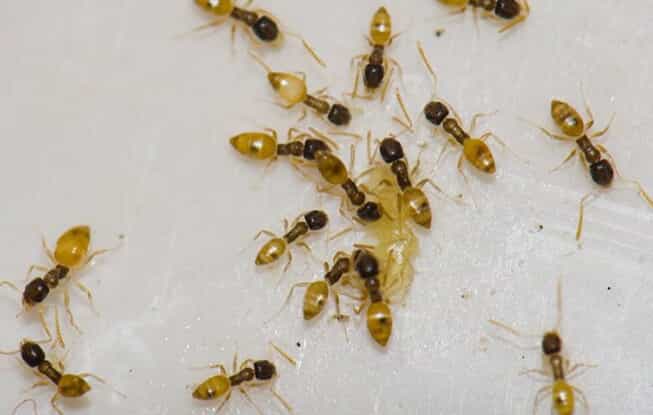
Argentine ants are a small species of ant that live together in large colonies. A single Argentine ant nest has the potential to have hundreds of thousands of workers and hundreds of queens. These ants are shiny and range from dark brown to black in color. Argentine ants can be identified by the well-defined trails they create between their nesting sites and food sources. In addition, Argentine ants emit a musty smell when they are crushed. The Argentine ant’s large colony size allows them to enter homes and other buildings in large numbers, making them rather difficult to eliminate. Once they gain entry, Argentine ants make quick work of contaminating food sources.
Outdoors, Argentine ants like to nest in the moist soil along sidewalks or under landscaping ties, stones, soil, and mulch. These pests will enter homes while foraging for food and during periods of dry weather or heavy rain.
To prevent these ants from finding their way into your home, it is important to control moisture levels in and around your home. Making sure your gutters are free of debris and are working properly to direct water away from your home, repairing any leaky faucets, fixtures, and pipes, using a dehumidifier in your basement to reduce moisture levels, sealing cracks and crevices in your foundation and caulking gaps that have formed around your exterior windows and doors, checking your screens to make sure they are completely intact, keeping tight-fitting lids on trash cans, and cleaning up your kitchen daily are all helpful tips in dealing with Argentine ants.
-
Bed Bugs
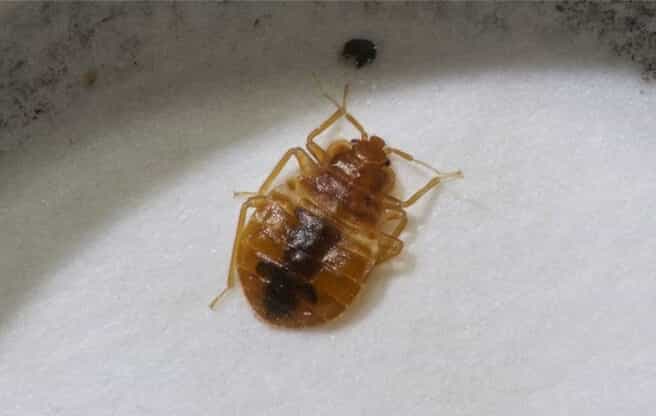
Bed bugs are common ectoparasites that feed on the blood of mammals, primarily that of humans. However, while humans are the bed bugs' preferred food source, if a human host is not available, these pests will settle for other warm-blooded mammals, including our pets. Adult bed bugs are about 1/4 of an inch long and have broad, oval-shaped bodies. Before feeding, bed bugs are reddish brown in color. However, after feeding, they turn a deep, reddish-purple color, and their body swells and elongates. Bed bugs have six legs, antennae, and are wingless. Immature bed bugs or nymphs look similar to adults, except they are smaller and translucent until they have their first blood meal, when they turn bright red in color.
Bed bugs can be found living in just about any place where people can be found. While traveling or out in public places, people often pick make contact with bed bugs in places like hotels, motels, airports, buses, taxis, shopping centers, hospitals, schools, dormitories, movie theaters, and libraries. Once that contact has been made, we often accidentally introduce those bed bugs into our homes. During the day, bed bugs squeeze their flat bodies into tight spaces such as cracks and crevices, inside wooden furniture, walls, flooring, seams of mattresses and box springs, behind window and door frames, light switches, electrical outlets, underneath piles of dirty laundry, behind loose wallpaper, and even inside keyboards and electronics. These pests then emerge at night to feed on the blood of their sleeping hosts.
Bed bugs are pervasive pests that can find their way into any home. To help avoid introducing bed bugs into your home, it's important to take the following precautionary steps: keep all personal belongings up off the ground in public places, avoid purchasing used furniture, mattresses, or box springs for your home, inspect your hotel room before bringing belongings inside, wash and dry all clothing that you took with you on high heat cycles after returning from a trip, regularly wash your family’s bedding and outerwear, vacuum your home and furniture on a regular basis, use a protective cover to encase mattresses and box springs, and reduce clutter throughout your home.
-
Black Widow Spiders
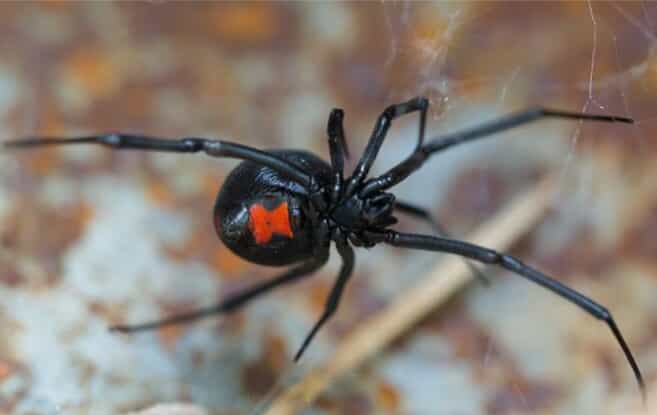
Black widow spiders are shiny black in color and have large, round abdomens. Female black widows can grow to between 1 1/2 to 1 3/8 inches in length, while the males of this species are about half the size of the females. These spiders have an identifying red hourglass marking on the underside of the abdomen; they can also have lighter red or white spots on their abdomens and backs. Black widow spiders are considered dangerous because their venom is strong enough to cause serious health concerns for humans. Black widow spiders use their potent venom to compromise the nervous system of their victims. Symptoms of a black widow spider bite may include vomiting, fever, chills, stomach pains, and difficulty breathing. If you ever suspect that you've been bitten by a black widow, contact a medical professional immediately.
Black widow spiders are usually found living outside between flat rocks, in woodpiles, near foundations, and inside barns, sheds, and other outbuildings. If they find their way inside while foraging for food, they can often be found hiding under furniture and in closets, attics, storage areas, and crawl spaces.
To help prevent dangerous black widow spiders from becoming a problem on your property, it is important to take the following measures: remove excess debris and clutters where those spiders can hide, keep outbuilding doors shut when not in use, store woodpiles a distance away from your home, seal cracks in your foundation, make sure your window and door screens are intact, and place weather stripping around all windows and doors to keep black widows from finding their way inside through the gaps.
To solve a black widow spider infestation in the safest manner possible, contact EcoTech to learn about our eco-friendly home spider control solutions.
-
German Cockroaches
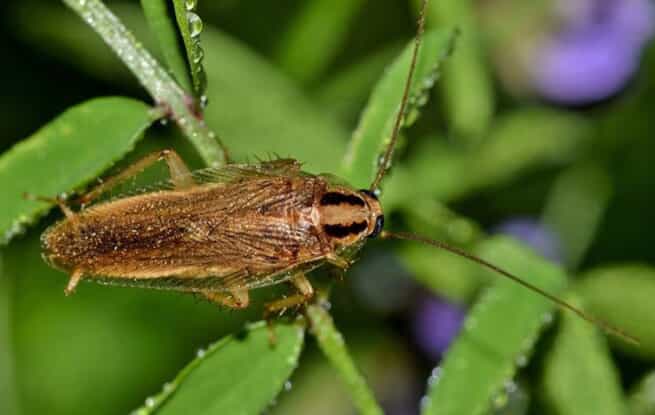
German cockroaches have flat, oval-shaped bodies and are light brown or tan in color. They have two distinctive black stripes running horizontally behind their heads. Adults roaches of this species grow to between 1/2 and 5/8th of an inch in length. German cockroaches have wings but rarely use them. Instead, they quickly dart from place to place, making them difficult pests to catch.
German cockroaches nest in warm, humid, secluded places that are located near food sources. Common nesting sites include behind appliances, under kitchen and bathroom cabinets, in laundry rooms, and in pantry areas. German cockroaches have the potential to introduce serious health risks to any home or business they invade. These pests carry bacteria, viruses, human pathogens, and parasites on their legs and body that they contaminate the surfaces and food items in your home with as they search for food, which can make you and your family members become very ill. In addition, the feces and shed skins that cockroaches leave behind are known to trigger allergies and severe asthma attacks in certain individuals, especially young children.
German cockroaches are attracted to moisture and are often drawn to our homes due to the high moisture levels they provide. Here are a few steps you can take to help make your home less attractive to them: reduce humidity levels and eliminate water leaks in and around your home, make sure gutters are clear and working properly, repair leaky pipes and fixtures, make sure crawl spaces are properly ventilated, use de-humidifiers to reduce moisture levels, seal gaps in your home’s foundation, exterior walls, and around utilities that enter your home through exterior walls, seal windows and doors to prevent cockroaches from finding their way inside, reduce food sources by keeping lids on trash cans, store food in the refrigerator or containers with airtight lids, and vacuum your home on a regular basis. The best way to prevent cockroaches is to contact EcoTech Pest Management for professional cockroach control in Sacramento, CA.
-
Roof Rats
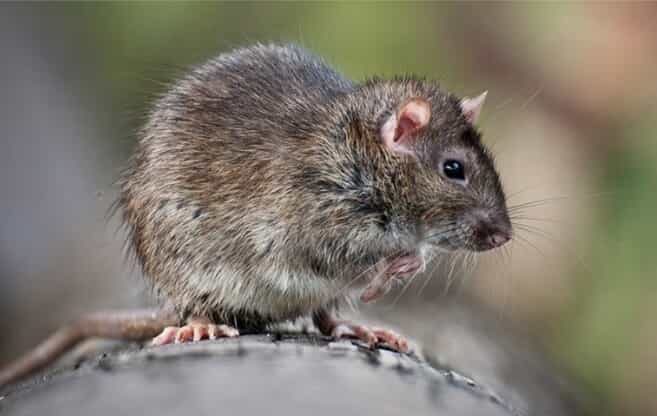
Roof rats are dark brown or black in color with gray highlights running through their fur. These rodents have pointed noses, big, dark-colored eyes, and large ears. Adults roof rats grow to about 8 inches long, and their tail adds an additional 6 to 8 inches to their total body length. These rats have long, slim bodies and are excellent climbers.
Outside, roof rats typically nest up high in trees, but can also be found living in burrows under plants, dense vegetation, and buildings, or inside woodpiles. Inside homes and other structures, roof rats live and nest in the upper levels of buildings - in attics and chimneys, behind walls, and above ceilings. As their name states, roof rats most often gain access to homes and other structures through the roof because of their ability to climb trees and other structures. Roof rats have the potential to contaminate homes or other structures that they have invaded with a wide variety of diseases, bacteria, and parasites.
To prevent problems with roof rats in your home, it is important to eliminate entry points and food sources. You can accomplish this by sealing spaces found in your foundation, roofline, and exterior walls, ensuring that your chimneys have tight-fitting caps, keeping pet food picked up between feedings, storing outdoor trash in receptacles with sealed lids, and storing all food items in airtight containers or in the refrigerator. The best way to prevent rodents is to contact EcoTech Pest Management for professional rodent control in Sacramento, CA.
-
Termites
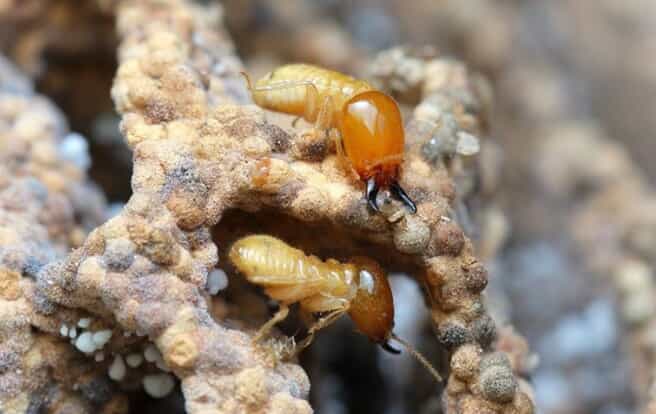
The eastern subterranean termite is one of the most common species of termite found living across the United States, as well as here in California. Termites are wood-destroying pests that are responsible for causing more than $5 billion worth of property damage to homes across the country each year! Termites are social insects and work together in large colonies. Within these colonies, there are several different castes that each serve a different purpose.
Worker termites make up the majority of a termite colony and are responsible for most of the structural damages caused to homes and businesses, as their primary responsibility is tunneling through wooden structures to gather food for their colony. These termite workers have soft creamy white bodies, no wings, are blind, and grow to be about ¼ of an inch in length. Soldier termites look quite similar to termite workers but are larger in size. They also have shorter legs and elongated, yellow-colored heads. Soldier termites are responsible for defending their colony with their strong jaws. The reproductive members of the termite are made up of kings, queens, and termite swarmers. The kings and queens of the termite colony are the largest members of the colony and are responsible for growing the populations of their colony. Swarmer termites look quite different from worker and soldier termites. These termites are larger, darker in color, and have four wings that are equal in length. Termite swarmers, also known as reproductives, swarm from mature colonies to find mates and create new colonies.
Termites enter homes and other structures while out foraging for food sources. They are especially attracted to homes and properties with moisture issues or water-damaged wood. When found infesting homes and other buildings, termites are considered damaging and dangerous insects. Termites have the unique ability to enter homes unnoticed and work for months, or even years, usually until the damage they have caused is finally noticed. If left untreated, a termite infestation can damage the structural integrity of the home they have invaded. Termites are moisture-seeking pests. To avoid problems with these wood-eating pests, there are a few steps you can take, including reducing the moisture levels in and around your home by using de-humidifiers or air-conditioners, making sure your crawl spaces are properly ventilated, maintaining your gutters to avoid excess moisture build-up, repairing any leaky pipes of fixtures, removing wood from your home that has been damaged by water, limiting wood-to-soil contact on your property, sealing cracks and crevices in your home's foundation, and creating a stone barrier between your foundation and any surrounding mulch or soil. The best way to prevent termites is to contact EcoTech Pest Management for professional termite control in Sacramento, CA.
-